Creating State Maps
Rachel Carroll, Mazama Science
October 23, 2020
Source:vignettes/articles/Creating_State_Maps.Rmd
Creating_State_Maps.RmdObjective
The goal of this document is to introduce the stateMap()
function in the MazamaSpatialPlots package. It
demonstrates default usage and customizations using the
stateMap() function’s arguments.
Default Plots
The stateMap() function requires two types of data.
First is a simple features data frame (SFDF) containing state level
polygons. The SFDF must include the variable stateCode in
it’s `` slot. The default SFDF is “USCensusStates_02”, which part of the
package data. Higher or lower resolution US Census state SFDFs can be
installed with:
library(MazamaSpatialUtils)
setSpatialDataDir('~/Data/Spatial_0.8') # default directory for spatial data
installSpatialData('USCensusStates_02')The second dataset is a regular dataframe that contains the variable
stateCode as well as a variable of interest. The variable
of interest from this dataset is indicated using the
parameter argument. This parameter is used to
determine the colors of states in the generated chloropleth map.
The next three examples demonstrate obtaining, summarizing, and
mapping state-level data. The first two use example dataframes from the
package and the third uses MazamaCoreUtils::html_getTable()
to easily pull data from a website.
Using package dataframe example_US_stateObesity
In this example, the package-internal dataframe,
example_US_stateObesity, is used directly:
library(MazamaSpatialPlots)
stateMap(
data = example_US_stateObesity,
parameter = 'obesityRate',
state_SFDF = "USCensusStates_02", # the default value
title = "Obesity Rate in U.S. States"
)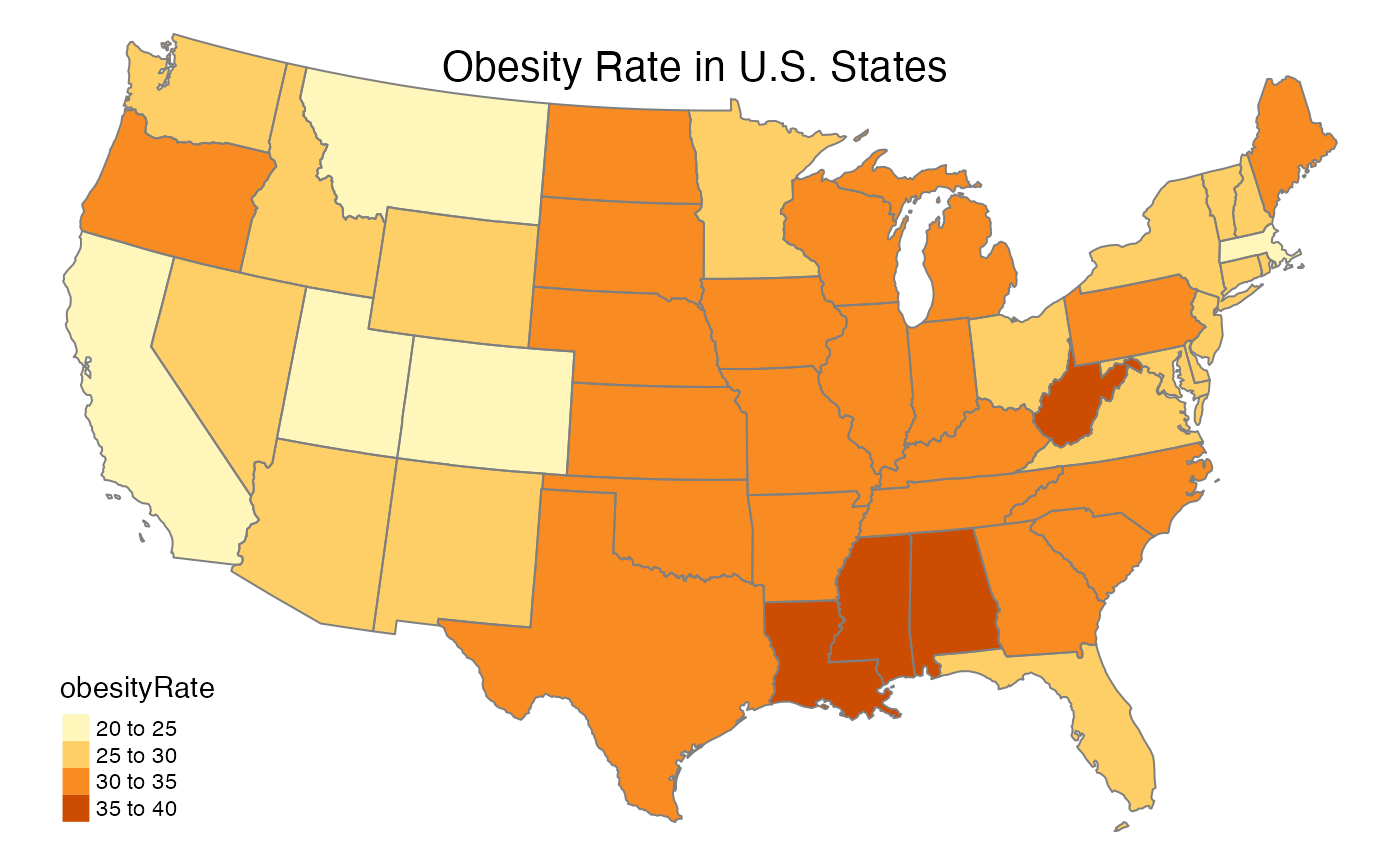
Using package dataframe example_US_countyCovid
In this example, the county-level package dataframe,
example_US_countyCovid, is aggregated by state and then
used:
library(dplyr)
example_US_stateCovid <-
example_US_countyCovid %>%
dplyr::group_by(stateCode) %>%
dplyr::summarise(stateCases = sum(cases), stateDeaths = sum(deaths)) %>%
dplyr::mutate(stateDeathRate = 100*stateDeaths/stateCases ) %>%
dplyr::select(c("stateCode", "stateCases", "stateDeaths", "stateDeathRate"))
stateMap(
data = example_US_stateCovid,
parameter = 'stateDeathRate',
title = "COVID Fatality Rates (%) on June 12, 2020"
)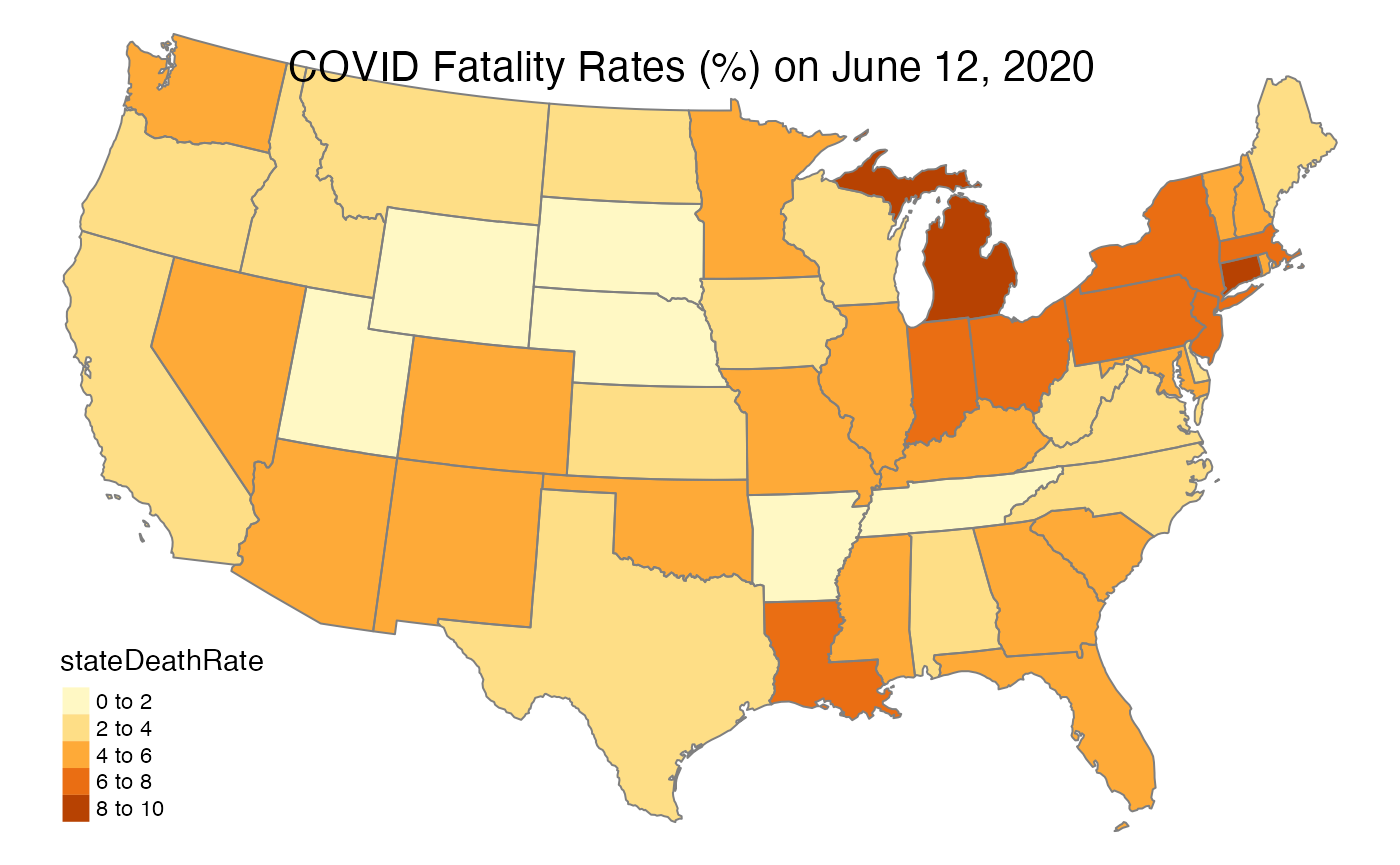
Using data found online
State-level data of interest can be found online and easily scraped
using MazamaCoreUtils::html_getTable() to parse all table
elements from a website. Using html_getTable() in
conjunction with stateMap() makes it very easy to extract
and visualize data from the internet.
URL <- "https://www.patriotsoftware.com/blog/accounting/average-cost-living-by-state/"
livingCostData <- MazamaCoreUtils::html_getTable(URL, header = TRUE)
livingCostData <-
livingCostData %>%
dplyr::mutate(
stateCode = MazamaSpatialUtils::US_stateNameToCode(.data$"State"),
avgAnnualWage = as.numeric(gsub('[$,]', '', .data$"Annual Mean Wage (All Occupations)")),
avgMonthlyRent = as.numeric(gsub('[$,]', '', .data$"Average Monthly Rent")),
rentWagePercent = 100*12*avgMonthlyRent/avgAnnualWage,
.keep = "none"
)
stateMap(
data = livingCostData,
parameter = 'rentWagePercent',
title = "Average Percentage of Income Spent on Rent"
)
Customizing with Function Parameters
In the above examples, the stateMap() inputs
data, parameter, state_SFDF, and
title are used to create maps. This section will
demonstrate how to use the other input parameters to customize your
map.
Using palette, breaks, and stateBorderColor
The palette, breaks, and
stateBorderColor parameters dictate the coloring of your
map. Colors are defined with palette and the distribution
of color across the map is defined with breaks. As
expected, stateBorderColor defines the state border
color.
To make the most of these parameters, see the following references for R colors and palettes:
In this example, breaks is used to create a coarser
coloring scheme and palette is used to customize the exact
color for each obesity rate level. The vector of breaks
will be one longer than the vector of colors.
stateMap(
data = example_US_stateObesity,
parameter = 'obesityRate',
palette = c("lightblue", "orange", "red"),
breaks = c(20, 27, 34, 40),
stateBorderColor = "black",
title = "Obesity Rate in U.S. States"
)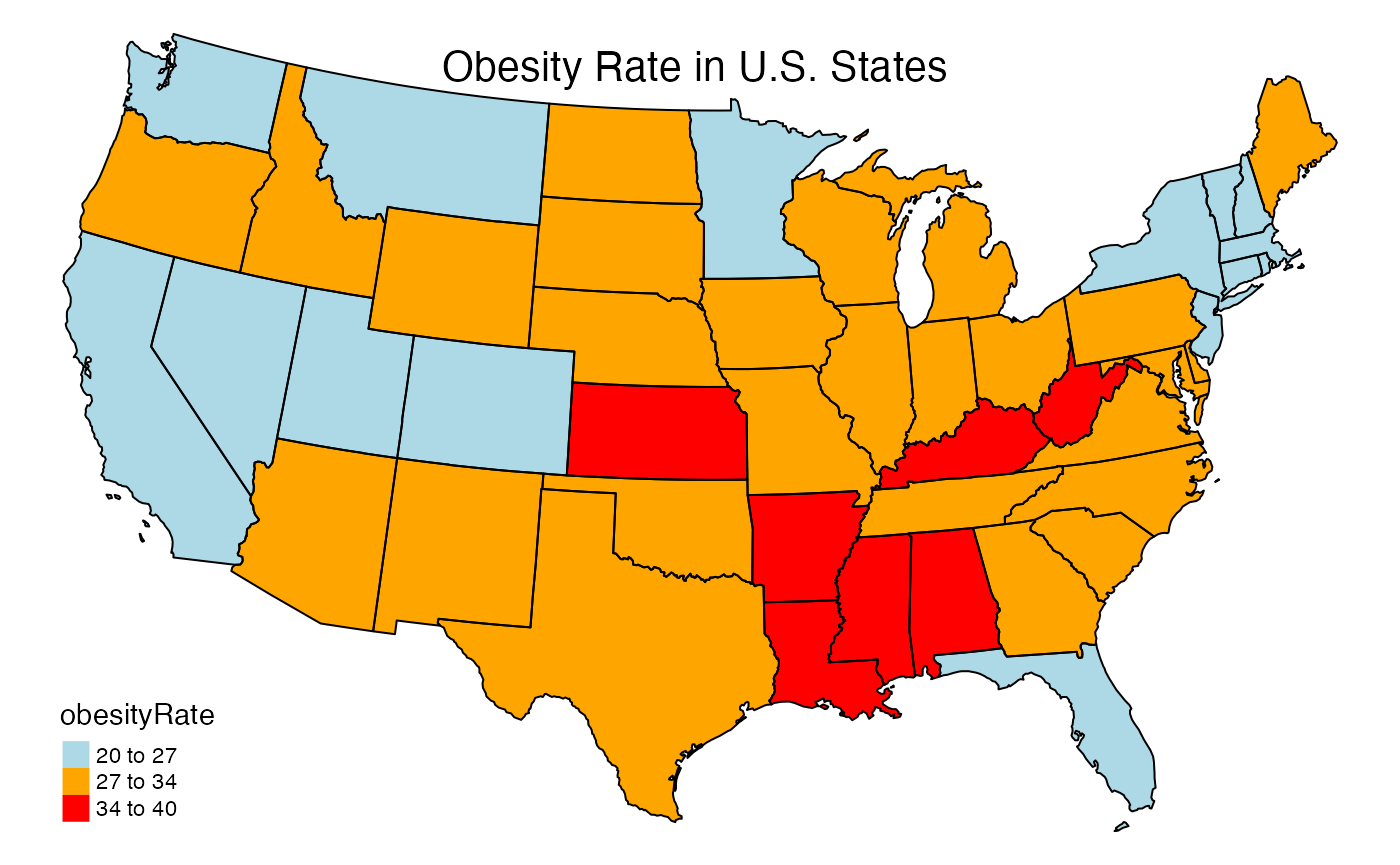
In this example, breaks is used to create a more
detailed coloring scheme and the RColorBrewer blue to
purple color palette name is chosen.
stateMap(
data = example_US_stateObesity,
parameter = 'obesityRate',
palette = 'brewer.bu_pu',
breaks = seq(20, 38, 3),
stateBorderColor = 'white',
title = "Obesity Rate in U.S. States"
)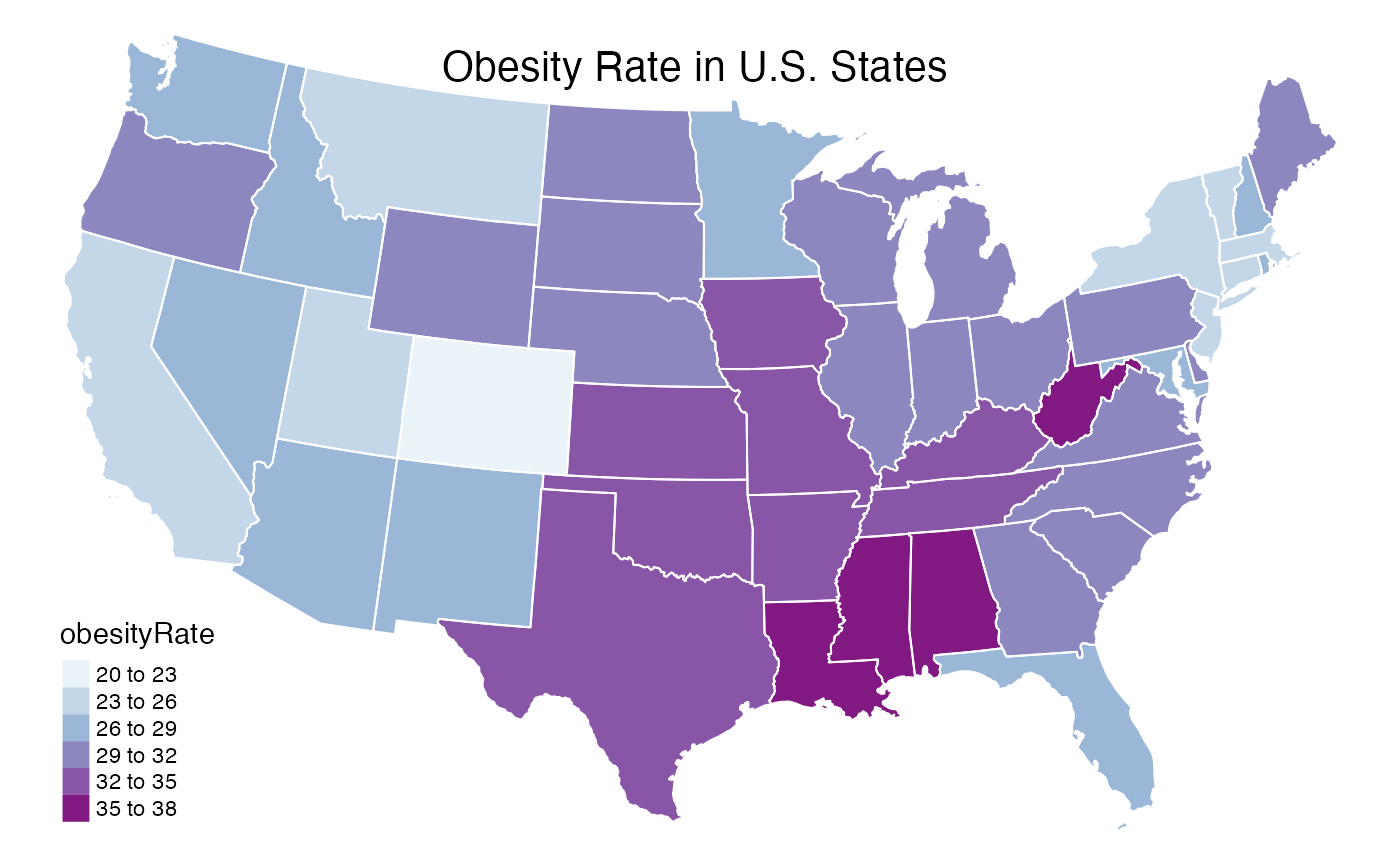
Using conusOnly and stateCode
The conusOnly and stateCode parameters
define which states will be included in the map. If
stateCode is defined, then conusOnly will be
ignored. If stateCode is not defined, then
conusOnly specifies whether the map is limited to the
continental US. When conusOnly = FALSE, the continental
U.S., Alaska, Hawaii, and U.S. Territories will be included.
This example builds upon the previous example and includes
stateCode specification to create a map of Western
states.
stateMap(
data = example_US_stateObesity,
parameter = 'obesityRate',
palette = 'brewer.pu_bu_gn',
breaks = seq(23, 31, 2),
stateCode = c("CA", "NV", "OR", "WA", "ID"),
stateBorderColor = 'black',
title = "Obesity Rate in Western U.S."
)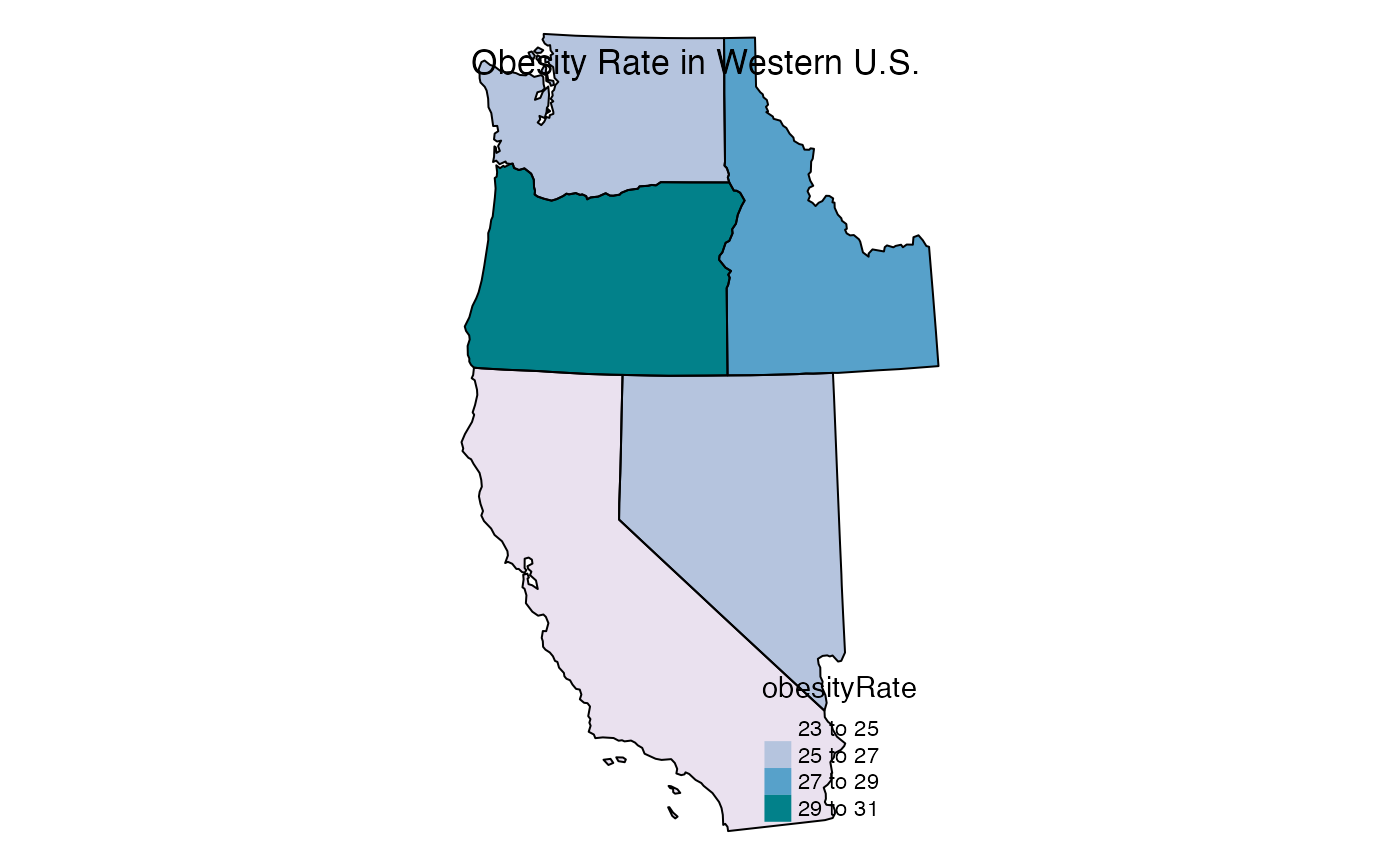
The following example uses conusOnly = FALSE.
stateMap(
data = example_US_stateObesity,
parameter = 'obesityRate',
palette = 'brewer.yl_or_rd',
breaks = seq(20, 38, 3),
conusOnly = FALSE,
stateBorderColor = 'black',
title = "Obesity Rate in U.S.",
legendPosition = tmap::tm_pos_in("right", "top")
)
Conclusion
The stateMap() function allows us to create attractive
maps with a minimum of effort. When used alongside
MazamaCoreUtils::html_getTable(), U.S. state data can be
procured and visualized in very few lines of code. The combination of
these two functions provides a great deal of flexibility. The
html_getTable() function opens up an endless source of data
from the internet while stateMap() can create highly
customized visualizations through direct inputs and by harnessing the functionality of the
tmap package.